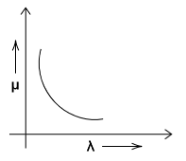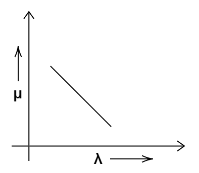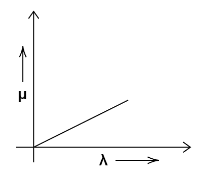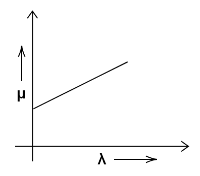
The correct curve between refractive index and wavelength will be
(A)

(B)

(C)

(D)





Answer
471.3k+ views
1 likes
Hint: When the light enters a medium other than the vacuum, it slows down according to the optical density of the medium. Thus the wavelength of the light changes when it travels from medium to medium. Before looking at the graphs, find the mathematical relation between
Formula used:
Complete step by step solution
The speed of light is not the same in different mediums. If a ray of light transmits from one medium to another, the speed of light changes. The medium in which the speed of light is faster is called the rarer medium and the medium in which the speed of light is slower is called the denser medium. When the speed of light changes, it also changes its direction and the light appears to be bending at the interface of the mediums. This bending of light is called refraction. To recognize the speed of light in a medium, we have something known as a refractive index. The Refractive index
It is defined as the ratio of the speed of light in vacuum
Since light is a wave, it has a frequency and a wavelength. The speed of a wave
Substitute the value of
Therefore,
When a wave light travels through different mediums, the frequency of the wave doesn’t change. Therefore, according to the equation
Consider the equation
Therefore, we can write the equation
Since
Take certain values of
The value
If we check the graphs, the best-suited graph for the above question is (A).
Note
Let us discuss why other graphs show incorrect relation between
Formula used:
Complete step by step solution
The speed of light is not the same in different mediums. If a ray of light transmits from one medium to another, the speed of light changes. The medium in which the speed of light is faster is called the rarer medium and the medium in which the speed of light is slower is called the denser medium. When the speed of light changes, it also changes its direction and the light appears to be bending at the interface of the mediums. This bending of light is called refraction. To recognize the speed of light in a medium, we have something known as a refractive index. The Refractive index
It is defined as the ratio of the speed of light in vacuum
Since light is a wave, it has a frequency and a wavelength. The speed of a wave
Substitute the value of
Therefore,
When a wave light travels through different mediums, the frequency of the wave doesn’t change. Therefore, according to the equation
Consider the equation
Therefore, we can write the equation
Since
Take certain values of
The value
If we check the graphs, the best-suited graph for the above question is (A).
Note
Let us discuss why other graphs show incorrect relation between
Latest Vedantu courses for you
Grade 10 | CBSE | SCHOOL | English
Vedantu 10 CBSE Pro Course - (2025-26)
School Full course for CBSE students
₹35,000 per year
Recently Updated Pages
Master Class 12 Business Studies: Engaging Questions & Answers for Success

Master Class 12 English: Engaging Questions & Answers for Success

Master Class 12 Social Science: Engaging Questions & Answers for Success

Master Class 12 Chemistry: Engaging Questions & Answers for Success

Class 12 Question and Answer - Your Ultimate Solutions Guide

Master Class 12 Economics: Engaging Questions & Answers for Success

Trending doubts
Give 10 examples of unisexual and bisexual flowers

Draw a labelled sketch of the human eye class 12 physics CBSE

Differentiate between homogeneous and heterogeneous class 12 chemistry CBSE

Write a short note on Franklands reaction class 12 chemistry CBSE

Differentiate between insitu conservation and exsitu class 12 biology CBSE

What are the major means of transport Explain each class 12 social science CBSE




